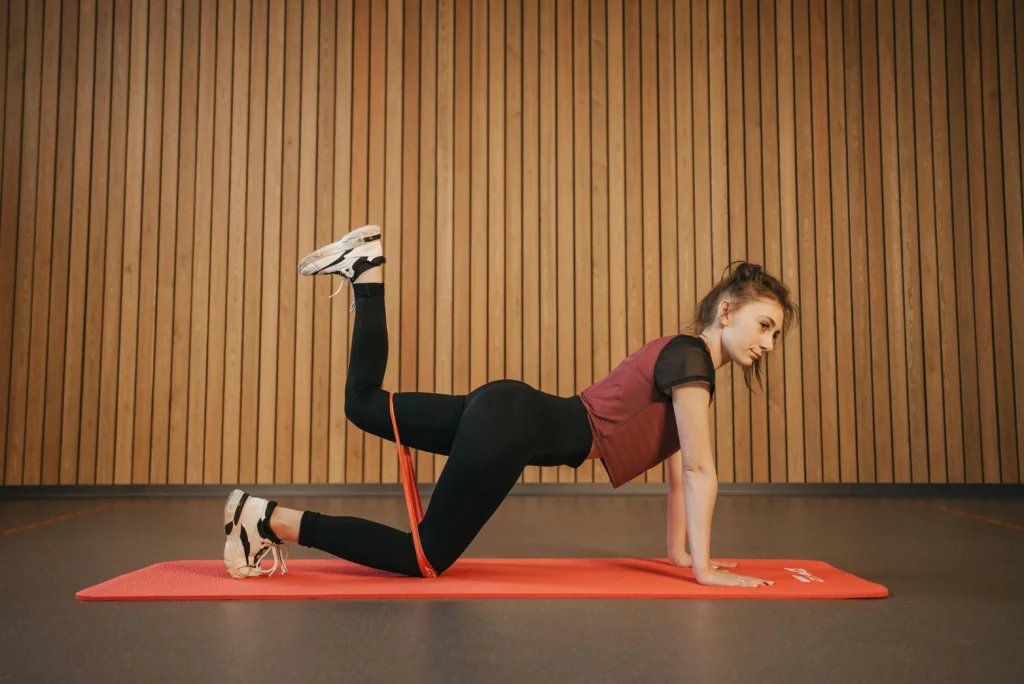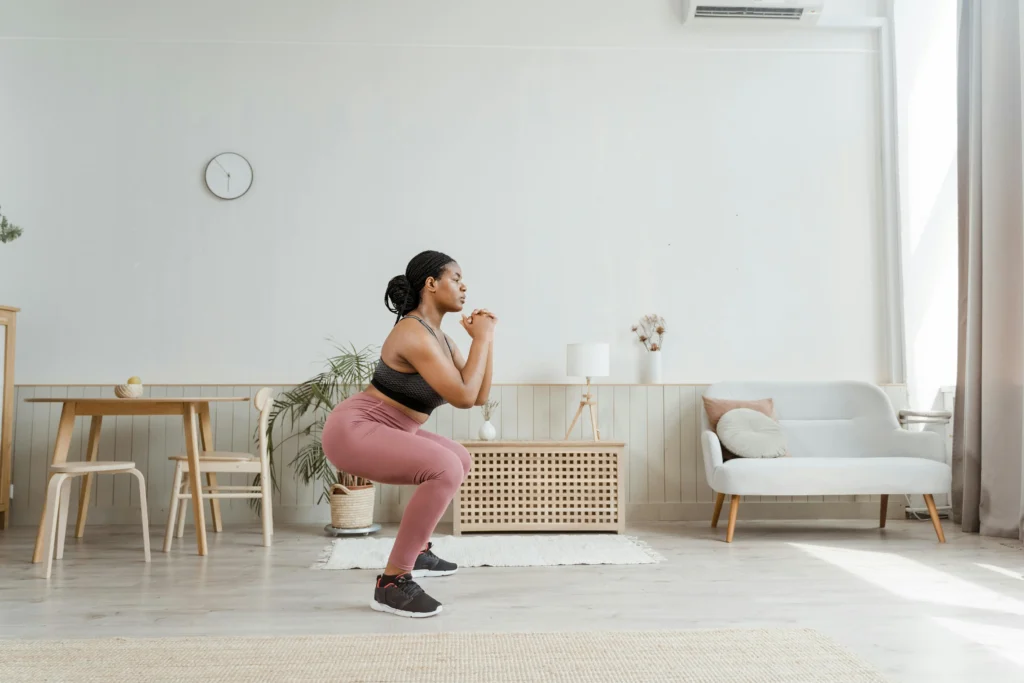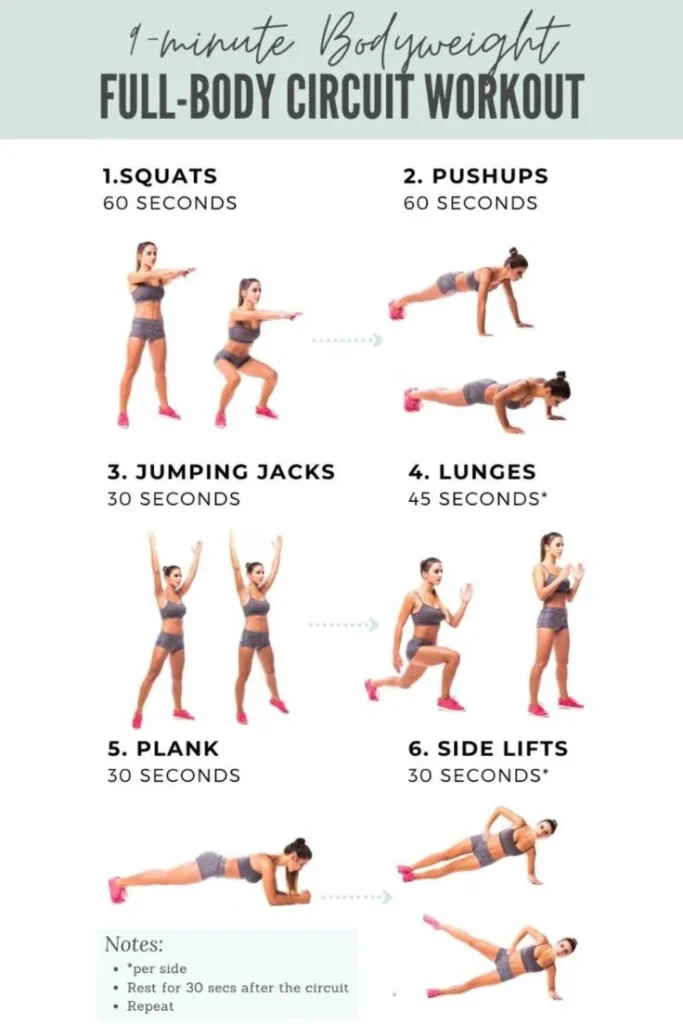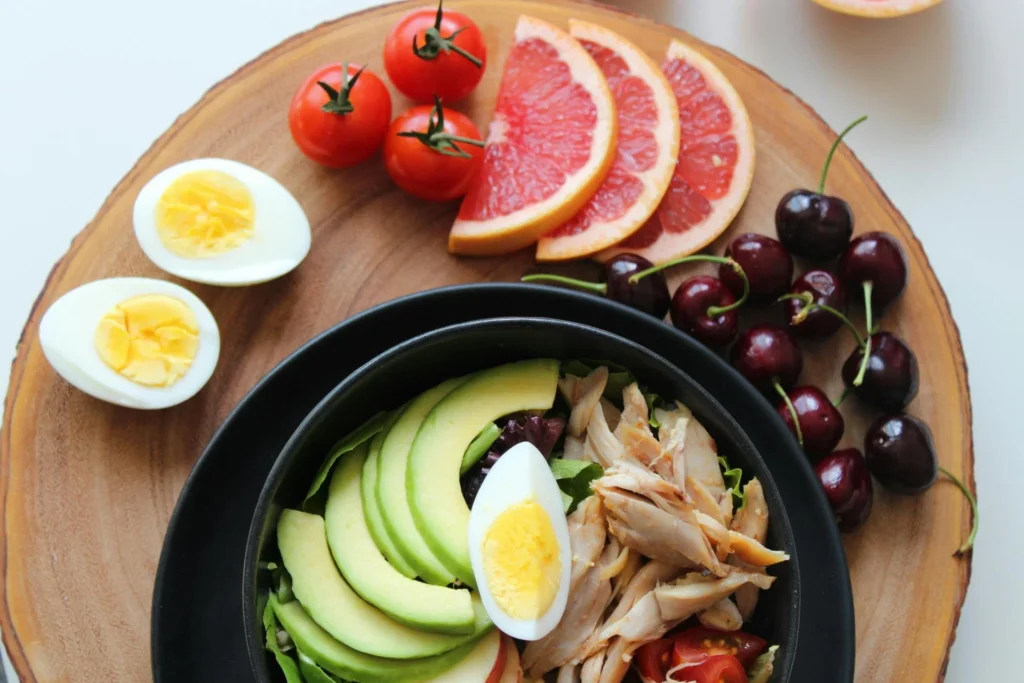Working out at home doesn’t have to be complicated or expensive! In fact, you can transform your fitness routine with just a few basic items and some creativity. Did you know that over 60% of people prefer home workouts since the pandemic? Whether you’re a busy professional, a parent with limited time, or someone just starting their fitness journey, this guide will show you exactly how to get fit with home workouts minimal equipment, without breaking the bank or cluttering your living space.

Why Home Workouts are the Perfect Solution for Beginners
When I first decided to get serious about fitness, the thought of walking into a packed gym made my palms sweat. No joke! I’m not exactly what you’d call a “gym person” – those intimidating machines, muscular regulars who seem to know exactly what they’re doing, and the constant feeling of being watched? Hard pass.
That’s when I discovered the absolute game-changer of home workouts. Look, fitness doesn’t have to be this scary, expensive endeavor that requires a PhD in exercise science or a trust fund for equipment. It can be as simple as clearing some space in your living room and committing to yourself.

Let me break down why home workouts are basically the superhero of fitness for beginners like me (and maybe you). First off, cost is a massive barrier for most people. Gym memberships can run you anywhere from $30 to $200 a month, not to mention the fancy workout clothes, transportation costs, and let’s be real – those overpriced protein smoothies you’ll definitely be tempted to buy.
Home workouts? They’re basically free after your initial minimal investment. We’re talking resistance bands that cost less than a fancy dinner, or using your own body weight for resistance. No membership required, no contract to sign, no awkward small talk with the front desk person.
Time is another huge win. Before home workouts, I was always making excuses. “Oh, the gym’s too far.” “I don’t have two hours to drive, change, workout, shower, and come back.” With home workouts, you eliminate all those barriers. Literally zero commute time. Got 20 minutes between Zoom meetings? Perfect. Want to exercise in your pajamas? Absolutely. No judgment, no audience, just you and your fitness goals.
Consistency is where most fitness journeys die, and home workouts are the ultimate consistency hack. When the barrier to entry is so low – literally just standing up and moving in your living room – you’re way more likely to stick with it. I’m not kidding when I say some of my best workouts have happened wearing mismatched socks and with Netflix playing in the background.
Privacy is another massive bonus. Let’s be real – when you’re just starting out, you’re going to look a little awkward. Your form might be off, you might be huffing and puffing, and you definitely don’t want an audience for that. Home workouts give you the ultimate safe space to learn, make mistakes, and gradually build confidence.

The mental game is huge too. Home workouts teach you something critical: fitness is about you, not about comparing yourself to some buff person next to you on a machine. You’re competing only with yourself, tracking your own progress, celebrating your own victories.
Pro-tip for beginners: start small. Really small. Like, a five-minute workout small. The goal isn’t to become a fitness model overnight; it’s to build a habit. Some days, five minutes is a win. Other days, you’ll find yourself doing 30 minutes without even realizing it.
By removing financial barriers, time constraints, and social anxiety, home workouts become this incredibly accessible path to fitness. They’re not just a workout – they’re a lifestyle adjustment that’s actually sustainable. And in a world of crazy fitness trends and impossible expectations, sustainability is the real victory.
So if you’re sitting there thinking, “I could never get fit” or “Workouts are not for me” – trust me, home workouts are about to change your entire perspective. No gym membership required.
Minimal Equipment for Home Workouts
When I first started my fitness journey, I thought I needed a garage full of equipment to get in shape. Spoiler alert: I was dead wrong. My wallet and my tiny apartment are proof that you can get an incredible workout with just a few affordable, space-saving items.
Let’s talk resistance bands – these magical elastic strips are basically the Swiss Army knife of home workout equipment. When I first bought a set, I was skeptical. How could something that looks like a giant rubber band actually help me build strength? But these bad boys are legit. You can use them for everything from leg exercises to upper body workouts, and they take up less space than a pair of socks.

Bodyweight exercises are the unsung heroes of home fitness. Zero equipment required, just you and gravity doing the work. Push-ups, squats, lunges – these are the bread and butter of any home workout routine. I remember my first attempt at a proper push-up. Let’s just say it was more of a controlled face-plant than an exercise. But that’s the beauty of working out at home – no one’s watching, and you can improve at your own pace.

Dumbbells are another game-changer, but you don’t need an entire rack. An adjustable dumbbell set is like the smartphone of workout equipment – multiple functions in one compact package. Pro tip: look for sets that allow you to change weights quickly. I made the mistake of buying individual dumbbells early on, and my small apartment looked like a weight room explosion.
The yoga mat might seem optional, but trust me, it’s not. It’s not just for yoga – it’s your personal workout zone. Protection for your floors, cushioning for your joints, and a dedicated space that says, “This is my fitness time.” I’ve done workouts on hardwood floors, and let me tell you, your knees will thank you for investing in a good mat.

Now, let’s talk about some optional but awesome additions. A jump rope? Absolute calorie-burning magic. It takes up virtually no space and can give you a hardcore cardio workout in just 10 minutes. A stability ball is another versatile piece that can double as a chair and a workout tool. Core exercises become way more interesting when you’re balancing on a giant ball.
Budget is always a concern, and I get it. When I started, I was working with basically zero disposable income. My first “weights” were actually water bottles filled with sand. Seriously. Creativity is your best friend in home fitness. Can’t afford a foam roller? A tennis ball can work wonders for muscle tension. No dumbbells? Filled water bottles, canned goods, or even backpacks with books can add resistance.
The most important piece of equipment? Your mindset. Sounds cheesy, but it’s true. You don’t need a ton of gear to get fit. What you need is consistency, motivation, and the willingness to start small.
A few key things to remember when building your minimal home gym:
• Quality over quantity
• Multi-purpose is your friend
• Start small and build gradually
• Don’t break the bank
• Focus on exercises, not equipment
Pro money-saving hack: Check Facebook Marketplace, Craigslist, and local buy/sell groups. People are constantly selling barely-used workout equipment at crazy discounts. I once scored a set of resistance bands and an adjustable dumbbell for less than $20. Total steal.
Your home workout setup doesn’t need to look like a professional gym. It needs to work for you, fit your space, and most importantly, get you moving. Whether that’s a corner of your living room, a small patch by your bed, or even outside in the park – fitness is about making it work with what you’ve got.
Remember, the best equipment is the equipment you’ll actually use. Don’t get caught up in having the perfect setup. Start simple, stay consistent, and watch yourself transform.
Creating Your Home Workout Space
Creating a home workout space isn’t just about finding a random corner to do some jumping jacks. It’s about designing an environment that actually motivates you to move, even when Netflix is calling your name.
When I first decided to get serious about home workouts, my “workout space” was basically a cramped corner between my couch and coffee table. Not exactly inspirational. I’d trip over shoes, knock over a lamp, and ultimately give up before I even started. Sound familiar? Trust me, your workout space can make or break your fitness motivation.
Let’s get real about creating a space that actually works. First off, you don’t need a massive home or a dedicated gym room. I’ve seen incredible workout spaces in studio apartments, tiny bedrooms, and even living rooms that double as office spaces. The key is intentionality.
Lighting is your secret weapon. Natural light can be a total game-changer. If possible, position your workout area near a window. There’s something about sunlight streaming in that makes you feel more energized. No windows? No problem. Invest in some bright, white LED lights that mimic natural daylight. Avoid those yellow, dingy lights that make you feel like you’re working out in a basement.

Flooring matters more than you might think. Hardwood or tile can be slippery and uncomfortable. A good yoga mat is a must, but if you’re serious, consider some interlocking foam floor tiles. They’re affordable, easy to clean, and provide that perfect cushioning for your joints. Pro tip: get dark-colored tiles if you’re worried about showing workout grime.
Storage is crucial. Nothing kills motivation faster than tripping over resistance bands or searching for dumbbells. I invested in a small, vertical storage rack that fits neatly in my workout corner. It keeps everything organized and – bonus – makes the space look intentional and professional.

Ventilation is something most people overlook. You’re going to be sweating, so make sure you can get some air circulation. A small fan can be a lifesaver, especially if you’re working out in a smaller space. Open a window if you can, or position yourself near an air vent.
Now, let’s talk motivation. This is where you get to personalize your space. I have a small whiteboard where I track my workouts and goals. Some people love motivational posters or quotes. Others prefer a mirror to check form. The key is to make the space feel like yours.

Technology can be your workout buddy. A small shelf or mount for a tablet or phone can help you follow along with workout videos. Just be careful not to turn your workout space into a tech disaster zone. Keep it simple and functional.
Here’s a pro hack: create a workout playlist and have a dedicated bluetooth speaker in your space. Music can be the difference between a sluggish workout and an epic one. I have a playlist specifically for workouts that gets me pumped up every single time.
Color psychology is real. If possible, choose a space with neutral or energizing colors. Avoid dark, gloomy corners that feel depressing. A splash of green from a plant or some bright artwork can make a huge difference in how you feel about your workout space.
Consider your entire body’s needs. Have a small towel nearby, a water bottle station, and maybe a small basket for any additional equipment you might need. The more prepared you are, the less likely you are to make excuses.
Tips for creating your perfect home workout space:
• Choose a consistent, dedicated area
• Invest in good flooring protection
• Maximize natural or bright lighting
• Keep equipment organized and accessible
• Add personal motivational touches
• Ensure good air circulation
• Make it functional, not fancy
Remember, your home workout space doesn’t need to be perfect. It just needs to work for you. Start with what you have, be creative, and most importantly, make it a space that excites you to move. Your fitness journey is about progress, not perfection.
The best workout space is the one you’ll actually use. Period.
Beginner-Friendly Workout Routines
Alright, let’s dive into beginner-friendly workout routines that won’t make you want to run and hide! When I first started working out, I thought I needed to become a fitness superhero overnight. Spoiler alert: that’s a recipe for burnout and frustration.
The secret sauce of any successful fitness journey? Consistency and smart programming. I learned this the hard way after countless failed attempts that left me exhausted, sore, and ready to give up. Let me save you from those same mistakes.
Full-body circuit training is your new best friend. This isn’t about spending hours in the gym or doing complicated moves that require a PhD in exercise science. We’re talking about simple, effective exercises that work multiple muscle groups and keep your heart rate up.
Here’s a sample beginner circuit you can do right in your living room with zero equipment:
Warm-up (5-7 minutes):
• Light jogging in place
• Arm circles
• Leg swings
• Gentle torso twists
Circuit (Repeat 2-3 times):
1. Bodyweight Squats (10-12 reps)
2. Push-ups (modified on knees is totally okay!)
3. Jumping Jacks
4. Walking Lunges
5. Plank
6. Side lift

The key is listening to your body. Some days, you’ll crush this workout. Other days, you might need to modify or do fewer reps. And that’s 100% okay. Fitness isn’t about perfection – it’s about showing up.
Strength training doesn’t require a ton of equipment. Bodyweight exercises are incredibly effective for building foundational strength. Push-ups, squats, and lunges are your bread and butter. Start with proper form over number of reps. I cannot stress this enough.
Cardio alternatives are everywhere. No treadmill? No problem. Jump rope, high knees, burpees, and even dancing can get your heart rate up. I’ve had some of my best cardio sessions just dancing around my living room like no one’s watching. Pro tip: they’re not watching.
Progressive overload is a fancy term that basically means gradually increasing the challenge. This could mean:
• Adding more reps
• Increasing workout time
• Making exercises more challenging
• Reducing rest time between sets

Flexibility and mobility are often overlooked by beginners. Don’t be that person who skips stretching! A 10-minute mobility routine can prevent injuries and improve overall performance. Think yoga-inspired movements that open up your body and increase range of motion.
Tracking progress is crucial. Not just for motivation, but to see how far you’ve come. I recommend a simple workout journal or a fitness app. Nothing fancy – just somewhere to log what you did, how you felt, and any improvements.
Rest days are not a sign of weakness. They’re a critical part of your fitness journey. Your body needs time to recover, rebuild muscle, and prevent burnout. I used to think rest days meant I was lazy. Now I know they’re when the real magic happens.
Sample Weekly Routine for Beginners:

Common beginner mistakes to avoid:
• Doing too much too soon
• Comparing yourself to others
• Neglecting proper form
• Skipping warm-ups and cool-downs
• Not staying hydrated
• Inconsistent workout schedule
Mental approach is everything. Some workouts will feel amazing. Others will feel like a struggle. The goal is to show up consistently, be kind to yourself, and understand that fitness is a journey, not a destination.
Pro tip: Find workouts you actually enjoy. Hate running? Don’t run. Love dancing? Make that your cardio. Fitness shouldn’t feel like punishment. It should feel like taking care of yourself.
Remember, everyone starts somewhere. That person who seems super fit? They were exactly where you are right now at some point. Your only competition is the person you were yesterday.
Start slow, be consistent, and watch yourself transform. Not just physically, but mentally and emotionally. Your workout routine is about so much more than just moving your body – it’s about building confidence, discipline, and a relationship with yourself.
Now get out there and crush those beginner workouts!
Nutrition and Recovery for Home Fitness Success
Nutrition and recovery are the unsung heroes of any fitness journey. Trust me, I learned this the hard way – through countless exhausting workouts, mysterious muscle aches, and more protein bar wrappers than I’d like to admit.
When I first started my fitness journey, I thought working out was the most important part. Spoiler alert: what you do outside of your workout matters just as much as the workout itself. Nutrition isn’t about some crazy diet or eliminating entire food groups. It’s about fueling your body to support your fitness goals and help you recover like a champ.
Let’s talk diet basics. Your body is like a high-performance vehicle – it needs the right fuel to perform. Protein is your best friend for muscle recovery and growth. But here’s the thing: you don’t need to go crazy with expensive protein powders or complicated meal plans. Whole foods are your secret weapon.
Simple protein sources that won’t break the bank:
• Eggs
• Chicken breast
• Greek yogurt
• Canned tuna
• Beans and legumes
• Cottage cheese

Hydration is something most people completely underestimate. I used to think drinking water during a workout was enough. Newsflash: it’s not. Proper hydration starts hours before your workout and continues long after. Aim for at least 8-10 glasses of water daily, more on workout days.
Meal prep can be a game-changer for consistent nutrition. I’m not talking about those perfectly Instagram-worthy meal prep containers. I mean simple, practical food prep that takes less than an hour on a Sunday. Cook in batches, use simple containers, and make it work for your lifestyle.

Recovery is where the real magic happens. Your muscles don’t grow during the workout – they grow during rest and recovery. This means paying attention to:
• Quality sleep (aim for 7-9 hours)
• Proper nutrition
• Active recovery techniques
• Stress management
Supplements can help, but they’re not magic pills. Most beginners don’t need a crazy supplement stack. If you’re eating a balanced diet, you’re probably getting most of what you need. A basic multivitamin and maybe some protein powder can be helpful, but don’t go broke trying to buy every supplement on the market.
Sleep is the most underrated recovery tool. I used to brag about surviving on 4-5 hours of sleep. Now I know better. Quality sleep is when your body repairs muscle tissue, balances hormones, and prepares you for your next workout. Aim for a consistent sleep schedule and create a relaxing bedtime routine.
Active recovery is your secret weapon. This doesn’t mean total rest, but lighter activities that keep you moving:
• Gentle yoga
• Walking
• Light stretching
• Swimming
• Casual bike rides
Nutrition timing can be simple. You don’t need to stress about eating exactly 37 minutes after your workout. Focus on:
• Eating within 1-2 hours after working out
• Getting a mix of protein and carbs
• Listening to your body’s hunger cues
Muscle soreness is normal, but excessive pain is not. Learn the difference between good muscle soreness and potential injury. A foam roller and some basic stretching can be incredible tools for recovery and preventing long-term muscle issues.
Mental recovery is just as important as physical recovery. Stress can completely derail your fitness progress. Find stress-management techniques that work for you:
• Meditation
• Deep breathing exercises
• Journaling
• Time in nature
• Talking with friends
Quick recovery meal ideas:

Common nutrition mistakes to avoid:
• Drastically cutting calories
• Ignoring nutrition entirely
• Relying too much on supplements
• Not drinking enough water
• Inconsistent eating habits
Pro tip: Track your progress, but don’t obsess. Take progress photos, note how you feel, track your energy levels. The scale is just one tiny piece of the puzzle.
Your nutrition and recovery are personal. What works for someone else might not work perfectly for you. Be patient with yourself, experiment, and find what makes you feel amazing.

Fitness is a journey, not a destination. Nutrition and recovery are your roadmap to success. Fuel your body, rest properly, and watch yourself transform – not just physically, but mentally and emotionally.
Now go crush those workouts and take care of yourself!



